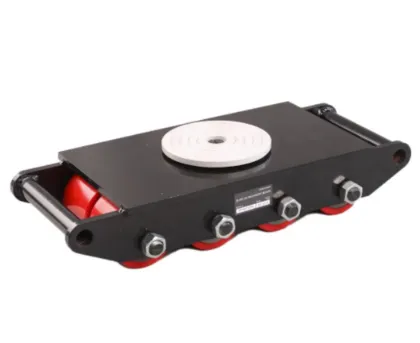Reliable Movement with Heavy Machinery Skates and Rollers
In modern industrial environments where precision, efficiency, and safety are paramount, moving large, delicate, or expensive equipment is a task that demands robust solutions. Whether transporting a CNC lathe, relocating sensitive servers, or installing oversized HVAC units, nothing substitutes the power and versatility of heavy machinery skates. Designed to handle immense weight loads with ease while protecting both the floor and the machinery, these tools provide a critical advantage to businesses across manufacturing, data infrastructure, and logistics sectors.

Precision and Strength: Heavy Machinery Skates in Action
The cornerstone of efficient equipment relocation lies in the smart application of heavy machinery skates. These load-bearing platforms are fitted with multiple rollers or wheels and built with high-strength steel frames that enable the smooth movement of tons of machinery with minimal force. What makes them particularly indispensable is their ability to distribute weight evenly, greatly reducing point loads that could otherwise damage floors or create dangerous imbalances.
Available in fixed or swivel versions, heavy-duty skates can be used solo for linear moves or as part of a larger system to handle multidirectional navigation. Some models feature padded tops for extra friction resistance, while others come equipped with rotating tops to adjust orientation while in motion. The rollers themselves may be constructed from steel for durability or polyurethane for quiet, floor-friendly performance.
These skates are used not only in traditional manufacturing and metalworking environments but also in heavy infrastructure and military installations—anywhere that the need to move something massive intersects with the need for care and control.
Smart Solutions from Movers for Heavy Equipment
There is no one-size-fits-all solution when it comes to movers for heavy equipment. Depending on the scenario, a business might require load skates, toe jacks, lifting gantries, rigging dollies, or a combination of all of the above. However, central to most heavy transport operations is the pairing of skates with hydraulic lifting tools and guiding tugs or winches.
The goal of movers for heavy equipment is not only to make the relocation possible but to ensure that it happens without risk to workers, machines, or facilities. That’s why most professional moving systems are designed with safety features such as non-slip surfaces, load-locking mechanisms, and reinforced bearings to handle both static and dynamic pressure.
For businesses that routinely handle large equipment—like printing presses, generators, or die-casting machines—integrating a moving system that combines skates with proper guidance tools significantly boosts both productivity and workplace safety. And because most skates are modular and compact, they’re easy to store and transport when not in use, further increasing their value across different job sites.
Protecting Assets with IT Equipment Movers
While industrial machinery is often designed to take a beating, sensitive devices like servers, data storage units, and laboratory equipment require a far more delicate approach. That’s where IT equipment movers come in. These are specialized moving systems that combine the weight-bearing strength of machinery skates with materials and structures that reduce shock, vibration, and static discharge.
Many IT equipment movers include foam padding, non-conductive coatings, and vibration-absorbing wheels to ensure that items like mainframes, switches, or control systems reach their destination unscathed. These movers are often used during data center builds, relocations, or upgrades, where timing, security, and precision are vital.
What sets these movers apart is not just the physical configuration but also the way they’re used. Often paired with lift tables or stair climbers, IT-specific movers are engineered for precise vertical and horizontal transitions in confined or sensitive environments. They support both rack-mounted and free-standing units and offer tie-downs and brackets to further secure loads during movement.
Versatile Applications of Machinery Skate Dolly and Machine Skates and Rollers
A machinery skate dolly is a hybrid transport tool that combines the maneuverability of a dolly with the strength of a load skate. These are especially useful when the equipment to be moved has a low center of gravity or lacks built-in wheels or casters. The dolly configuration provides a sturdy platform for mounting equipment, and when paired with handles or towing bars, it becomes a flexible tool for steering in tight spaces.
Machine skates and rollers play a crucial role in multi-point relocation strategies. In many heavy-load applications, especially those involving odd-shaped or unbalanced objects, multiple skates are used in coordinated motion. This allows the weight to be evenly spread out across a larger area, dramatically reducing strain on any single point and minimizing risk.
Their modular design enables adaptability: roller sets can be reconfigured, rotated, or linked together using bars or chains to handle various geometries and weight distributions. These tools are used not only in factories but also in museums, stadiums, and theaters where large set pieces, sculptures, or even grand pianos need precise, damage-free movement.
Modern skates are also optimized for different surfaces—from epoxy-coated concrete floors to rough, outdoor industrial pads. Polyurethane rollers are ideal for quiet indoor use, while steel or cast iron rollers can withstand heat, debris, or rugged terrain.
Machinery mover FAQs
What is the difference between heavy machinery skates and standard skates?
Heavy machinery skates are designed for much larger load capacities compared to standard furniture or equipment skates. While basic skates might support a few hundred kilograms, heavy-duty versions can handle tens of tons. They also feature reinforced frames, industrial-grade rollers, and safety mechanisms like non-slip platforms or load guides to ensure stability during transit. These skates are engineered to move industrial machinery rather than general office equipment.
How do IT equipment movers prevent damage to sensitive electronics?
IT equipment movers are tailored to handle delicate and high-value items like servers and network gear. They use shock-absorbing wheels, foam padding, non-conductive surfaces, and secure strapping mechanisms to minimize vibration and static buildup during movement. Some advanced models also include suspension systems or anti-tip designs to further reduce the risk of damage. These features help protect fragile electronic components from internal displacement or short circuits.
Can a machinery skate dolly be used on uneven floors?
Yes, but with caution. A machinery skate dolly works best on smooth and level surfaces, but some models are designed with oversized wheels or shock-absorbing rollers that can handle minor inconsistencies in flooring. However, if the floor has significant slopes, debris, or uneven transitions, it’s advisable to use reinforced tracks or support boards to ensure safe operation and avoid tipping or wheel damage.
How do machine skates and rollers handle turns or curved paths?
Machine skates and rollers often come in two forms: fixed and swivel. Fixed skates are ideal for straight-line movement, while swivel-top skates or those with rotating bases allow for directional changes. For curved paths or tight spaces, swivel skates are placed at the front of the load to steer the movement, while fixed skates support the rear. Additionally, steering bars and towing ropes can be attached for controlled maneuvering.
What kind of maintenance is required for heavy machinery skates?
Maintenance for heavy machinery skates is minimal but important. Regular inspections should be carried out to check for worn rollers, cracked frames, or damaged bearings. Polyurethane wheels should be cleaned of debris and inspected for flat spots. Steel components may need occasional lubrication and rust prevention treatments. Always store skates in a dry, secure place and avoid overloading beyond rated capacities to ensure longevity and safety.
-
Dawei Hand Pallet Truck 1200mm, 2000–5000 KGS Heavy-DutyখবরNov.17,2025
-
Dawei Hand Pallet Truck, Fork Length 1200mm, 2000–5000kgখবরNov.17,2025
-
Large Equipment Movers – Safe, Insured & On-Time ServiceখবরNov.17,2025
-
Machine Moving Dollies | Heavy-Duty, Low-Profile, SafeখবরNov.17,2025
-
Permanent Lifting Magnet - Heavy-Duty, Safe, Quick ReleaseখবরNov.11,2025
-
PML 1000 Lifting Magnet - Heavy-Duty, Safe, No PowerখবরNov.11,2025
-
Large Equipment Movers: Safe, Fast, Certified ProsখবরNov.11,2025
